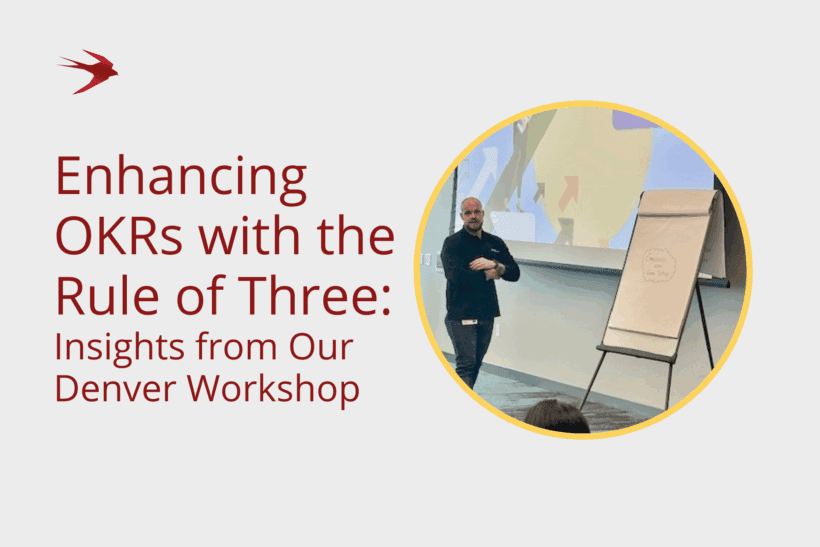If you’re reading this article, you’re likely either a leader in an organisation that is about to go through, or going through an Agile Transformation, or you’re working closely with leaders to guide them through it.
Most people are now familiar with how adopting an agile mindset and applying agile practices impacts the people who are doing the work on the products, services and solutions, but a question that we are often asked by managers and leaders is “What can I do to ensure that this Agile transformation is successful?”.
Well, continue reading for the answer! We’ve shared 5 things you must do as a leader for successful Agile Transformation below.
5 Things That Managers & Leaders Need to do for a Successful Agile Transformation
1. Lead by Example
“… we lead not by the example of our power, but by the power of our example.” – Joe Biden, President of the United States
The most powerful thing managers and leaders can do when leading an Agile transformation is to lead by example. What does that mean exactly? Leading by example is guiding your people and teams and inspiring them to action through your actions, behaviours and mindset.
Some ways that you can lead by example are:
- Be authentic – follow through with promises, listen, support your teams because you want to
- Align your teams – align and motivate the teams to the transformation vision
- Be part of the transformation – attend training, workshops and planning sessions
- Invest in your learning – education is key in any Agile transformation and you, as a leader, are not exempt from this
- Add value to the team – try simply asking your team how they need you to show up and what you can do to help
[Case Study] A Successful Agile Transformation
2. Commit to an Agile Mindset
A truly successful Agile Transformation is a system-wide adoption. We are asking our teams and people to follow the Agile Manifesto and 12 Principles through our product development processes – and managers and leaders should look to apply these values and principles too.
As a leader, when you are required to make a decision, a priority call, trade off or compromise, before executing the decision, think about the Agile Manifesto and ask yourself “does my decision contradict any of the principles of the Agile Manifesto?”. If the answer is “yes”, then perhaps you would like to consider how you could make a decision to compliment the principles instead.
The more you use the principles to guide your thinking, the more natural your Agile mindset will feel.
We developed a group activity for teams understand the Agile Manifesto! You can download the Build Your Own Manifesto template that I use here.
3. Protect Your People
“Servant leadership” is a popular term amongst the Agile community. The phrase first came to prominence in 1970 in a paper by Robert K. Greenleaf titled “The Servant as a Leader”.
Servant leadership is a leadership behaviour style focusing on the needs of your teams and people above your own needs, as opposed to more traditional forms of leadership are focused on the needs of the organisation and/or individual.
As a leader, you can apply these behaviours by actively supporting and protecting your teams. Change is hard. There will be bumps along the way and the people closest to the work are often the ones who are impacted the most. Look after these people, listen to them and empower them.
Learn 5 tools and techniques that every agile leader needs to know >
4. Focus on the Things That the Teams Can’t Solve Themselves
One way that you can be a valuable part of the wider team is to help the team by removing organisational blockers.
These are usually the big issues that your teams are raising that they are unable to solve themselves. If your teams don’t have the authority to solve the issue, if the blocker requires significant spend, if organisational complexity is interfering or if they are stuck on some priority calls, you may need to step in.
Find out what’s stopping your teams be at their best and help them solve it. Once it’s solved, work on ensuring that it doesn’t get in the team’s way again.
5. Get out of the way!
“It doesn’t make sense to hire smart people and then tell them what to do. We hire smart people so they can tell us what to do.” – Steve Jobs, Co-founder of Apple
Finally, just get out of the way! If you’ve successfully led by example, committed to and displayed an agile mindset, are protecting your people and removing the blockers that the teams cannot solve themselves, then leave the teams to do what you hired them to do, trust that they are aligned and motivated to do all that they can to deliver great products and services.
Ensure the Success of Your Agile Transformation
We hope that you’ve found this article useful and that we’ve answered the question; “what does management need to do for a successful Agile Transformation”. Now, check out our article on how to create an Agile Transformation Roadmap.
If you’re looking for more help and support to improve collaboration, quality, experimentation and delivery, take a look at our group coaching series or get in touch to discuss our bespoke Agile consultancy service.


